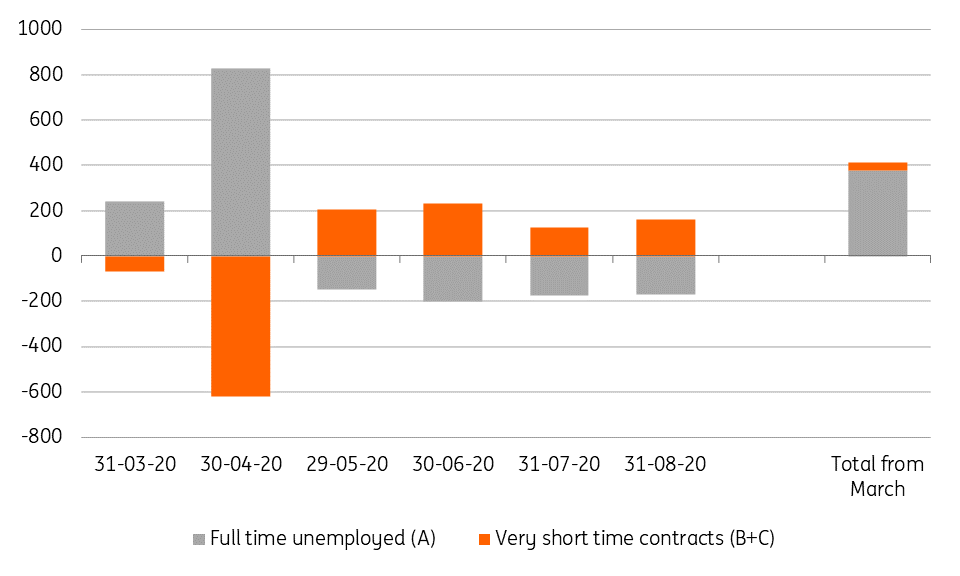France: Unemployment continues to fall
In France, the number of unemployed continued to fall in August. It seems that the situation of the 2.4 million people who were still on short-time work in July did not, therefore, tip over into unemployment in August. However, the risk of a less dynamic recovery in 4Q could change this situation
A drop in unemployment that is merely statistical
Unemployment statistics for the month of August suggest that the trend observed in recent months is continuing. The number of fully unemployed fell by 171,000 in August, as in July, implying that the total fall in the number of unemployed since April is 694,000. However, this decrease hides a shift between categories of unemployed. On the basis of a breakdown of the figures by category, it can be observed that some of the full-time unemployed in the period April-May (when more than one million temporary workers – temporary agency and short contracts – lost their jobs) appear to have found partial employment. This means that the increase in the number of unemployed observed during the period of containment and the decrease observed since then is mainly caused by the population composed of people with short or occasional contracts. With the deconfinement, these individuals therefore appear to have returned to the pace of activity they previously held.

The short-time working system limits the impact of the crisis on the labour market for the time being
The Ministry of Labour reports that the number of workers on short-time working has fallen sharply in recent months (the latest figures show 2.4 million employees in this situation in July, compared with 4.5 million in June and 8.8 million in April). It therefore seems that, for the time being, this reduction in recourse to short-time working has not led to a strong increase in the number of unemployed, indicating that job losses due to bankruptcies or restructuring are still low in France at present.
The end of the year is likely to coincide with an increase in the unemployment rate
Thereafter, as long as short-time working measures are extended and companies avoid bankruptcy through credit, the rise in unemployment could remain limited. But the resurgence of the epidemic is a risk to the labour market, especially given the new measures announced this week and their impact on confidence (see our article here). It is therefore likely that by the end of the fourth quarter of 2020, the unemployed population will have increased by more than half a million people over the year, bringing the unemployment rate to 10.5% (compared with 7.9% in the fourth quarter of 2019). In fact, the end of the credit repayment "truces" declared by the European Banking Authority for the coming weeks and the probable increase in business bankruptcies could tip some of the 2.4 million workers still in short-time work into full-time unemployment. As the most vulnerable workers (who also have the highest propensity to consume) will be disproportionately affected (as they are over-represented in the most affected sectors such as tourism), we believe that this will weigh on the recovery of private consumption throughout 2021.
Download
Download articleThis publication has been prepared by ING solely for information purposes irrespective of a particular user's means, financial situation or investment objectives. The information does not constitute investment recommendation, and nor is it investment, legal or tax advice or an offer or solicitation to purchase or sell any financial instrument. Read more
